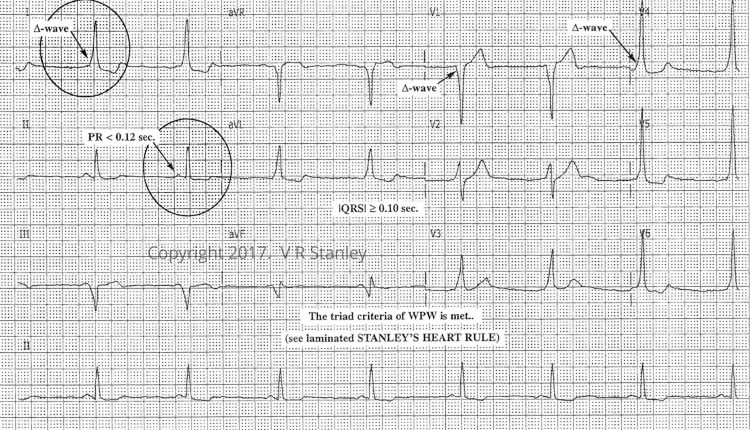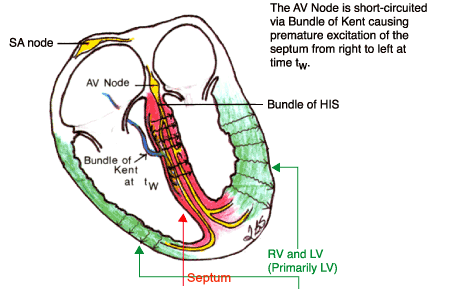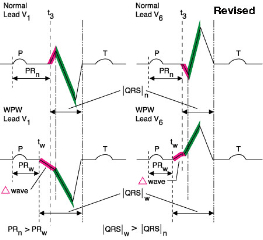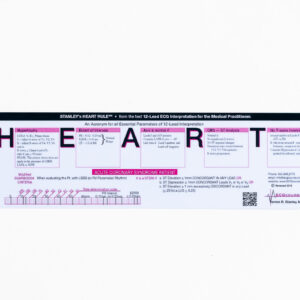(C) 2024 ECGcourse.com LLC. All rights reserved. | Vernon Stanley, MD, PhD Author | Courtney Stanley, MSPA-C Editor
In this 12-lead ECG Blog, we will discuss pre-excitation and specifically Wolff Parkinson White (WPW) Syndrome and the short PR interval. Before proceeding, please answer the following questions (answer key is at the bottom of this post):
Question 1. The Wolff Parkinson White (WPW) pattern is sometimes referred to as the great imposter because it sometimes will mimic:
- A. Myocardial Infarction
- B. LVH
- C. Ischemia Changes
- D. Bundle Branch Block pattern
- E. All of the Above
Question 2. In Wolff Parkinson White syndrome, the reentry circuit which creates the Short PR interval occurs via the:
- A. Bundle of HIS
- B. Bundle of Sgarbossa
- C. Bundle of Kent
- D. None of the Above
Question 3 | True or False: In Wolff Parkinson White syndrome, a Delta wave, most commonly visible prior to the QRS complex, is present in every lead of the 12-lead ECG.
- True
- False
A congenital defect, Wolff Parkinson White affects 0.3% of the population worldwide and is more common in people of Chinese descent according to the Cleveland Clinic. Wolff Parkinson White on the 12-lead ECG was first described in 1930 by Louis Wolff, John Parkinson & Paul Dudley White (Pre-excitation syndromes • LITFL • ECG Library Diagnosis).
On the 12-lead ECG, Wolff Parkinson White Syndrome (WPW as it is most commonly labeled) is often referred to as the “great imposter” on the 12-lead. A common mimic of the Wolff Parkinson White syndrome is the old Myocardial Infarction. You will frequently find on the 12-lead ECG of a Wolff Parkinson White patient, significantly wide Q-waves in the inferior leads (Leads II, III & avF). This will often be interpreted by the computer as an “old inferior MI”. However, these Q-waves usually do not reflect an MI but are simply secondary to the Wolff Parkinson White. Therefore, the WPW on the 12-lead ECG can present a pseudoinfarction pattern.
Please review the 12-lead ECG tracing below and note the Wolff Parkinson White (WPW) distortions which demonstrate wide Q waves in Leads III & avF (pseudoinfarction).

Although a fairly uncommon finding, it is important to discuss the Wolff Parkinson White syndrome predicted 12-lead ECG wave shape. The general category of the preexcitation syndrome (of which Wolff Parkinson White is an example) is the result of a congenital abnormality of the electrical conduction system of the heart. There are several variants on the theme, but for examples’ sake, let us consider the specific case of Wolff Parkinson White and the Bundle of Kent. This is a special situation where an accessory pathway exists which short circuits the AV (atrio ventricular) node. The AV node is the primary reason for the long duration of the PR interval (0.12 to 0.20 sec), since the conduction across the AV node is extremely slow. In the case of Wolff Parkinson White, the Bundle of Kent has short-circuited the AV node, and it follows that the PR interval will be short, i.e. a PR < 0.12 sec. The electrical signal will travel via the Bundle of Kent and will depolarize the ventricle earlier than usual (the ventricle is pre-excited). The Bundle of Kent is composed of myocardial tissue and its electrical conduction is slow, nevertheless much more rapid than that traversing the AV node. Please see the diagrams below demonstrating the Bundle of Kent and its effect on the resultant waveform.


There are three important observations to make about the above illustration of WPW.
- The PR-interval is shortened by the Bundle of Kent. More specifically, the PR < 0.12 sec.
- The QRS duration is widened because of the early depolarization of the septum. More specifically: |QRS| > 0.10 sec
- When the electrical signal and depolarization wavefronts rejoin the old pathways, there is a sudden change in direction (instantaneous slope change) in the QRS waveform. This portion of the waveform is called a Delta wave. The provider should be aware that the Delta wave may not be apparent in all the leads and certainly may be negative in some leads.
In summary, the classic triad criteria for the WPW is as follows:
- |QRS| > 0.10 sec
- PR < 0.12 sec
- Presence of Delta wave in some of the leads
The important conclusion is as follows: If one measures a short PR-interval on the ECG, one should “think” Wolff Parkinson White and proceed to look for the presence of the other two criteria. It is no trite statement to say that if you do not look for the WPW, you will never find it.
Treatment for Wolff Parkinson White syndrome depends on the patient’s symptomatology, as the patient may indeed be asymptomatic and may need no treatment at all. In the ER setting, if the patient is symptomatic, treatment depends on presentation, lab results, consult with cardiology and the patient’s PCP, serial ECGs and comparison with an old ECG when available. Treatment may include:
- Antiarrhythmics
- Electrical shock therapy
- Catheter ablation
Answer Key
Question 1. The Wolff Parkinson White (WPW) pattern is sometimes referred to as the great imposter because it sometimes will mimic:
- A. Myocardial Infarction
- B. LVH
- C. Ischemia Changes
- D. Bundle Branch Block pattern
- E. All of the Above
Question 2. In Wolff Parkinson White syndrome, the reentry circuit which creates the Short PR interval occurs via the:
- A. Bundle of HIS
- B. Bundle of Sgarbossa
- C. Bundle of Kent
- D. None of the Above
Question 3 | True or False: In Wolff Parkinson White syndrome, a Delta wave, most commonly visible prior to the QRS complex, is present in every lead of the 12-lead ECG.
- True
- False
Resources & Additional Reading:
- Wolff-Parkinson-White (WPW) Syndrome | Doctor (patient.info)
- WPW syndrome: Rare cause of sudden cardiac death in young people – Symptoms and causes – Mayo Clinic
- Wolff-Parkinson-White Syndrome (clevelandclinic.org)
- Pre-excitation syndromes • LITFL • ECG Library Diagnosis
-
Sale Product on sale
 HEART Ruler Mnemonic Pocket Guide
HEART Ruler Mnemonic Pocket Guide$15.00Original price was: $15.00.$9.95Current price is: $9.95. -
 50 ECG Case Studies Course (13 Hrs CME)$145.00
50 ECG Case Studies Course (13 Hrs CME)$145.00 -
 Advanced 12-Lead ECG Interpretation Course (30 Hrs CME)$499.00
Advanced 12-Lead ECG Interpretation Course (30 Hrs CME)$499.00
Questions?
